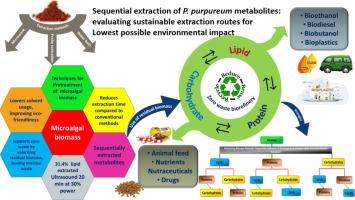超声波和微波连续提取卟啉代谢物的研究。
IF 4.5
2区 生物学
Q1 BIOTECHNOLOGY & APPLIED MICROBIOLOGY
Algal Research-Biomass Biofuels and Bioproducts
Pub Date : 2025-08-01
DOI:10.1016/j.algal.2025.104276
引用次数: 0
摘要
微藻生物量因其快速生长和高脂含量而日益成为可持续生物燃料生产和高价值副产品提取的有吸引力的资源。然而,传统的提取方法往往依赖于大量的溶剂,导致环境退化。本研究提出了创新的方法来减少溶剂的使用和浪费,同时利用先进的超声波和微波预处理技术提高脂质提取和有价值的代谢物的顺序回收。本研究旨在通过有效地破坏紫斑卟啉坚硬的细胞壁,减少对过多溶剂体积的需求,提高紫斑卟啉的脂质提取效率。在甲醇:氯仿混合物(1:2 v/v)中,以30%功率运行20分钟,证明了FUSE的效率最高,脂质得率为31.4±0.41%,同时减少了提取时间和溶剂消耗。蛋白质和碳水化合物含量分别为32.14±0.35%和35.2±0.22%。脂质提取后,对剩余生物量进行蛋白质、碳水化合物和生物活性物质的顺序回收,分为蛋白质-脂质-碳水化合物和脂质-蛋白质-碳水化合物两个序列。这些序列的最大副产物回收率分别为69%的脂肪和57%的碳水化合物,65%的蛋白质和52%的碳水化合物。这些顺序提取过程最大限度地利用了资源,最大限度地减少了浪费,并展示了符合可持续发展目标7和循环经济原则的零浪费方法。这些发现强调了微藻生物精炼厂的潜力,通过采用绿色、溶剂最小化的提取技术来减少生物燃料和生化生产对环境的影响,从而提高资源效率和可持续性。本文章由计算机程序翻译,如有差异,请以英文原文为准。

A sustainable ultrasonic and microwave-assisted sequential extraction strategy of metabolites from Porphyridium sp.
Microalgal biomass is an increasingly attractive resource for sustainable biofuel production and the extraction of high-value co-products due to its fast growth and high lipid content. However, conventional extraction methods often rely on large volumes of solvents, contributing to environmental degradation. This study proposes innovative approaches to minimize solvent use and waste while enhancing lipid extraction and sequential recovery of valuable metabolites using advanced ultrasonic and microwave pretreatment techniques. The current study aimed to enhance lipid extraction efficiency from Porphyridium purpureum by effectively disrupting its rigid cell walls and reducing the need for excessive solvent volumes. FUSE, operated at 30 % power for 20 min with a methanol:chloroform mixture (1:2 v/v), proved the most efficient, achieving a lipid yield of 31.4 ± 0.41 %, while reducing extraction time and solvent consumption. Protein and carbohydrate contents were quantified at 32.14 ± 0.35 % and 35.2 ± 0.22 %, respectively. Post lipid extraction, sequential recovery of proteins, carbohydrates, and bioactives were carried out with residual biomass, two sequences: protein-lipid-carbohydrate and lipid-protein-carbohydrate. These sequences resulted in maximum co-product recovery of 69 % lipid and 57 % carbohydrate, and 65 % protein and 52 % carbohydrate, respectively. These sequential extraction processes maximized resource utilization, minimized waste, and demonstrated a zero-waste approach aligned with Sustainable Development Goal 7 and circular economy principles. The findings highlight the potential of microalgal biorefineries to reduce the environmental impact of biofuel and biochemical production by adopting green, solvent-minimizing extraction technologies that enhance resource efficiency and sustainability.
求助全文
通过发布文献求助,成功后即可免费获取论文全文。
去求助
来源期刊

Algal Research-Biomass Biofuels and Bioproducts
BIOTECHNOLOGY & APPLIED MICROBIOLOGY-
CiteScore
9.40
自引率
7.80%
发文量
332
期刊介绍:
Algal Research is an international phycology journal covering all areas of emerging technologies in algae biology, biomass production, cultivation, harvesting, extraction, bioproducts, biorefinery, engineering, and econometrics. Algae is defined to include cyanobacteria, microalgae, and protists and symbionts of interest in biotechnology. The journal publishes original research and reviews for the following scope: algal biology, including but not exclusive to: phylogeny, biodiversity, molecular traits, metabolic regulation, and genetic engineering, algal cultivation, e.g. phototrophic systems, heterotrophic systems, and mixotrophic systems, algal harvesting and extraction systems, biotechnology to convert algal biomass and components into biofuels and bioproducts, e.g., nutraceuticals, pharmaceuticals, animal feed, plastics, etc. algal products and their economic assessment
 求助内容:
求助内容: 应助结果提醒方式:
应助结果提醒方式:


